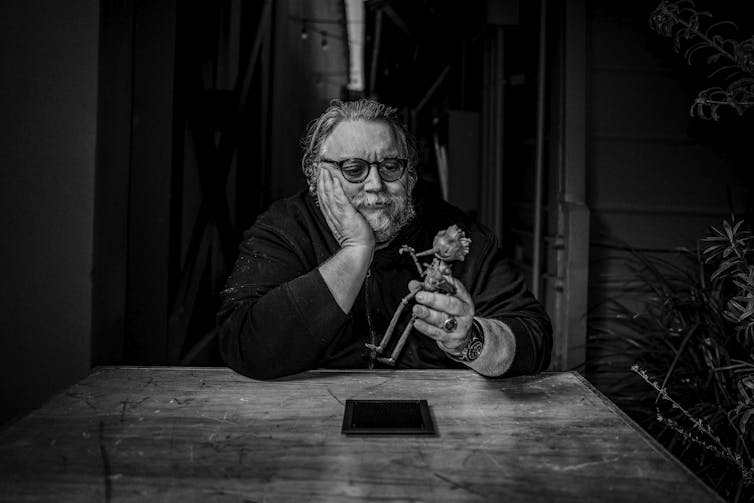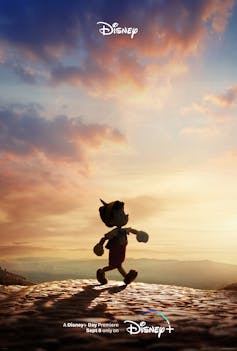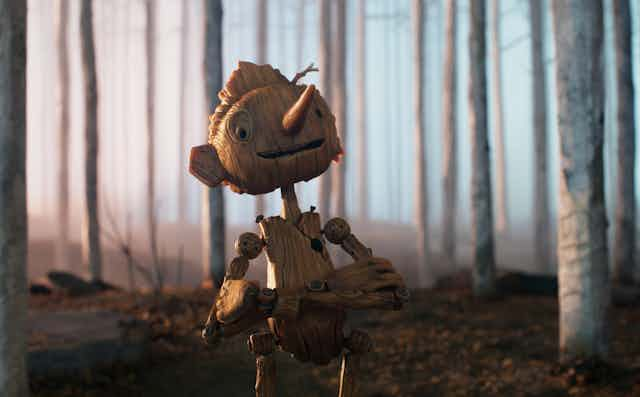That Guillermo del Toro would eventually create a version of Pinocchio feels something like cinematic destiny. The overriding theme of his cinematic vision is, afterall, a love for those others would see as freaks, outcasts or misfits.
The Mexican-born filmmaker began work as a special effects illustrator and make-up designer before making his first feature film, Cronos, in 1993 – a fable about a girl’s deep bond with her vampiric grandfather.
Since then, del Toro has forged an international career making films in both Spain and the US, and won the Academy Award for Best Director for The Shape of Water in 2017.
It is no surprise that just as Cronos concerns a girl trying to protect her undead grandfather, Pinocchio involves a father trying to protect a replacement for his deceased son. Pinocchio presents a climax of many of the core elements that have dominated del Toro’s career to date.
As a scholar of del Toro’s work, I interviewed him in 2015. He spoke, even then, of his ambitions for Pinocchio, and his belief that “animation is in many ways the future of genre movies”. He explained that the only thing hindering his ambitions was a “way to capture randomness”.
Clearly, he found it. His depiction of Pinocchio’s world has a satisfyingly cluttered, haphazard style, not least in the unpolished nature of Pinocchio himself, who is carved by a drunk, grieving Geppetto.

The broken and unfinished state of Pinocchio’s body is symbolic of his outsider status. Del Toro once again populates his film with misfits, disregarded and disenfranchised – those lost in a chaotic world.
Many viewers were introduced to del Toro’s work with Pan’s Labyrinth (2006), which told the story of a young girl, Offelia, trapped in a manipulative and cruel relationship with her Spanish fascist stepfather, Captain Vidal. Offelia is offered an escape through a terrifying set of challenges by the mysterious Faun (whose costume is made, incidentally, from ancient looking wood – perhaps another nod to Pinocchio) in an adult fairytale set against the Spanish Civil War.
This notion of the abandoned child, whose future is fought over by those seeking to alter their destiny, can be seen in many of del Toro’s other works. In The Devil’s Backbone (2001) we follow Carlos, a 12-year-old orphan of the Spanish civil war who finds himself in a haunted orphanage, surrounded by danger.
In Hellboy (2004) a demon child is unleashed by Nazis attempting to enhance the supernatural, and is rescued by a scientist who raises him to protect civilisation. He becomes a father figure, but later dies, leaving Hellboy abandoned and cursed by his own difference.
Guillermo del Toro’s Pinocchio is a culmination of the director’s artistic preoccupation with the abandoned and unwanted child. In del Toro’s oeuvre, these children become symbolic of the future of a world at war.
A mockery of fascism
Del Toro sets his Pinocchio in Fascistic Italy, where military bombs have killed Geppetto’s “real” son, setting the tale in motion.
Some might see this blending of historic reality and fantasy as crass. But through del Toro’s commitment to the rendering of his worlds, the appearance of the fantastical is never jarring, but assumed, as much a part of the fabric of reality as the bombs of the Fascist regime.

Italian prime minister Benito Musollini is depicted attending Pinocchio’s circus act, and is presented as a ludicrous, bloated man-child. Pinocchio is supposed to provide a fawning tribute, but instead goes off script, comically mocking the regime. This further illuminates the grotesque childishness of the Fascist agenda in a manner reminiscent of Charlie Chaplin’s famous depictions of Hitler and his floating globe.
Navigating the “uncanny valley”
It’s significant that Pinocchio is del Toro’s first animated feature, (although he worked on the TV show Trollhunters between 2016 and 2021), not least because of the style of animation used.

Stop-motion offers a visually stunning alternative to other notable Pinocchios – a lived in, grimy aesthetic, which echoes the darker, more mature elements of del Toro’s version.
It also eliminates the “uncanny valley” problem (as faced by Robert Zemeckis in his own interpretation earlier this year) where there is an inherent creepiness to the CGI figures. In Guillermo del Toro’s Pinocchio, all of the characters look strange in one way or the other, and the presence of a talking cricket and a wooden child seem not to disturb the inhabitants of his world too much.
Instead, at the film’s core is a testament to humanity summed up by the wooden boy’s proclamation that “life is such a wonderful gift.” This sentiment, coupled with a heartbreaking closing sequence – made all the more moving because of the real world relevance that runs through the film – places Guillermo del Toro’s Pinocchio as a worthy addition to his growing body of work.
It’s an oeuvre which advocates for the future of the young and shines a light on the childish futility of warmongering. Using fantasy and genre fiction, del Toro once again gives voice to those who might otherwise be disregarded as “freaks”.

